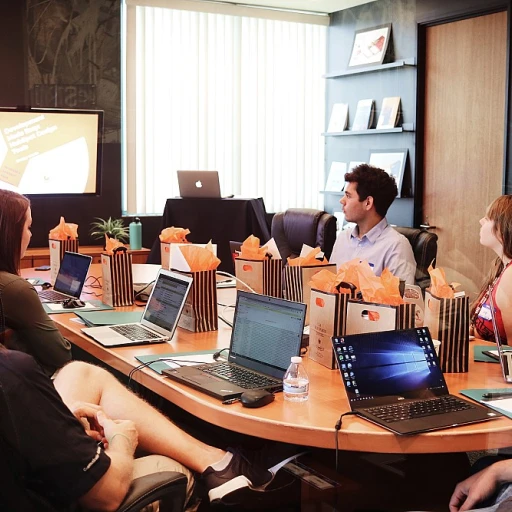
Adapting Training Methods for Remote Environments
Reimagining Training for Virtual Spaces
The shift to remote work has significantly transformed how businesses approach employee training. As companies embrace remote working, it's crucial to adapt training methods to suit this new environment. The need for effective remote training programs has never been more critical, given the widespread shift towards working remotely. Remote training presents unique challenges and requires innovative strategies to ensure employees develop the necessary skills for their roles. Training programs need to cater to remote employees, focusing on maintaining productivity, enhancing communication, and supporting continuous learning.- Online Learning Platforms: Digital tools are now at the core of remote training. Platforms like LMS (Learning Management Systems) allow remote workers to access training materials online, engage in self-paced learning, and participate in virtual classrooms. This adaptability makes it easier to fit training into employees' work life.
- Interactive Training Sessions: Engaging remote employees can be challenging, but leveraging interactive elements such as virtual workshops, webinars, and simulations can help retain their attention. These methods encourage active participation and make learning more practical and impactful.
- Blending Traditional with Digital: A hybrid approach, combining face-to-face methods (via video conferencing) and digital resources, can enhance learning experiences. This strategy supports employees' diverse learning styles and development needs, offering a more comprehensive training experience.
Challenges in Remote Training Implementation
Addressing Obstacles in Virtual Training Programs
Implementing remote training comes with its unique set of challenges, requiring human resources professionals to adopt innovative approaches to maintain the effectiveness of their programs. One of the main hurdles is ensuring that employees remain engaged in an online setting. Unlike traditional in-person training, virtual sessions can struggle with keeping workers' attention, especially when they're juggling the demands of their daily tasks while working remotely.
Moreover, communication barriers in remote work environments can affect the delivery and reception of training content. Without the benefit of face-to-face interactions, articulating complex ideas or concepts becomes more difficult. This lack of physical presence can lead to misunderstandings that hinder learning development and the overall effectiveness of the training program.
Adapting to various levels of technical proficiency among employees is another challenge. Not all remote workers might be equally comfortable or capable with new online learning platforms and tools. This discrepancy can slow down the rate of skill development and make it harder for employees to engage in continuous learning.
To support remote employees effectively, human resources teams must develop strategies to bridge these gaps. This includes offering training resources tailored to different proficiency levels and incorporating interactive learning tools that enhance employee training and development. Similarly, regular check-ins and feedback loops can help identify and address any persisting issues quickly.
For more insights on overcoming these challenges, HR professionals can explore resources on enhancing human resources through technology, which provides valuable strategies and tools.
Innovative Tools and Technologies
Harnessing Advanced Platforms and Digital Technologies
Incorporating state-of-the-art digital tools and platforms is crucial for facilitating effective remote training. Various online tools and platforms can significantly enhance the learning development experience for employees by providing an interactive and flexible learning environment. Many organizations now utilize learning platforms that offer a range of features such as personalized training programs, real-time feedback, and progress tracking to support continuous learning.
A particularly successful tool in this domain is the use of immersive training sessions through platforms that simulate real-life scenarios. These platforms allow remote employees to gain hands-on experience in a controlled digital setting, which helps in the development of crucial skills without the need for physical presence.
- Video conferencing tools are instrumental in maintaining face-to-face communication and team collaboration, thereby promoting a more engaging work environment.
- API integrations with other work systems ensure that training programs are seamlessly integrated into the daily work routine of remote workers.
- AI-driven analytics offer deeper insights into employee progress and productivity, enabling HR teams to tailor remote training programs more effectively.
Moreover, leveraging these innovative digital technologies addresses some of the challenges faced in remote training implementation by offering scalable solutions that can adapt to the needs of remote teams.
Integrating these tools also supports the development of soft skills which are essential for remote work. By enabling timely learning and skill-building, organizations can better prepare their workforce for the evolving demands of working remotely.
In conclusion, cutting-edge online tools and platforms play a pivotal role in enhancing employee training, thereby ensuring that employees are well-equipped to face the complexities of working remotely, maximizing both productivity and team capability.
Measuring Training Effectiveness Remotely
Evaluating the Impact of Remote Learning Solutions
Effectively measuring the impact of learning and development in a remote work environment presents both opportunities and challenges. Remote training programs offer flexibility, allowing employees to learn at their own pace, but it is crucial to ensure these sessions are effective. For accurate evaluation, leveraging various online tools becomes indispensable. These tools facilitate real-time feedback and analytics, enabling a comprehensive understanding of training effectiveness. It is essential to focus on the following metrics:- Engagement Levels: Measure how active remote employees are during training sessions. Engagement often reflects the quality of the training material and the facilitator's skills.
- Skill Retention: Evaluating whether employees retain key skills post-training can be done through formative assessments and real-time quizzes integrated into learning platforms.
- Application of Skills: Analyzing how learning translates into real-world application is crucial. Regular check-ins and surveys can determine how employees apply the skills gained through remote training in their tasks.
- Feedback Loops: Encourage continuous feedback from employees participating in remote work training. This feedback should guide improvements and further development of training programs.












